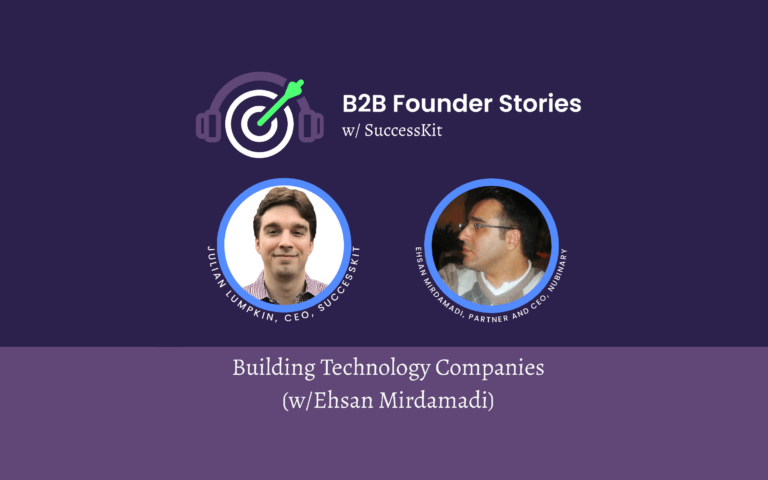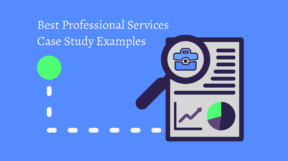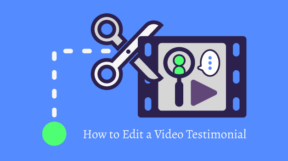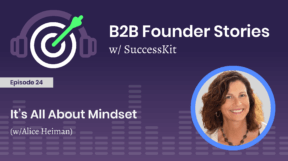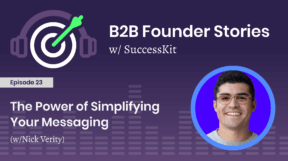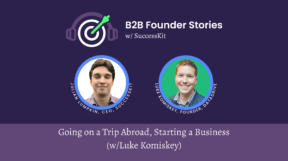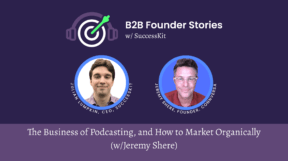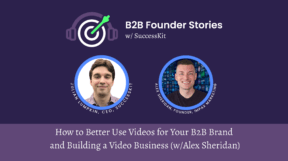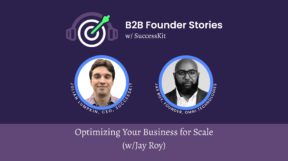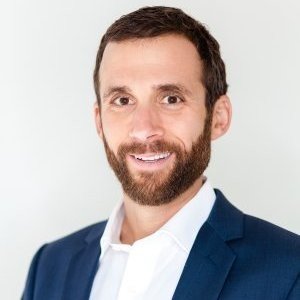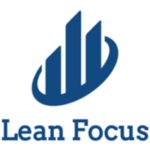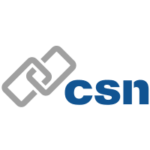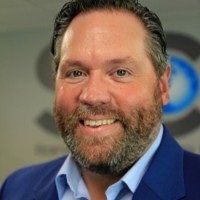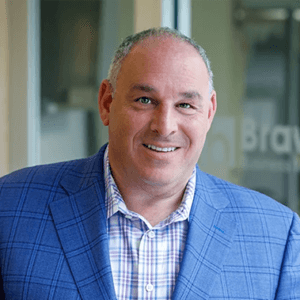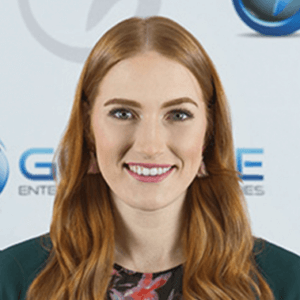Listen to this episode now on Spotify or Apple!
Ehsan Mirdamadi, partner and CEO of NuBinary, joins us on our B2B Founder Stories podcast to tell us about his experience starting multiple tech companies, including NuBinary, which provides Chief Technology Officers (CTOs) to tech startups. He identifies why he co-founded NuBinary and describes his unique take on the CTO role based on what he’s observed in his career. He also explains how NuBinary operates with four technical co-founders and names the key differences between running a professional services firm and running a tech business.
“A lot of people put a lot of emphasis on the tech when it comes to the tech leadership, and what we have learned is that it’s usually not so much about the tech—rather what it is about understanding the business’s objectives and dealing with and managing people in the entrepreneurial journey and experience. What we define the CTO to be is the person who can actually marry the business objectives and the technical objectives of the company and see if it actually even makes any sense to build a technology piece for what they are trying to achieve.”
Ehsan Mirdamadi, Partner and CEO of NuBinary
Transcript of Podcast Episode 16: Building Technology Companies (w/Ehsan Mirdamadi, Partner and CEO of NuBinary)
Julian Lumpkin: Welcome back to B2B Founder Stories w/ SuccessKit. My guest today is Ehsan Mirdamadi. He is the founder and CEO of NuBinary. In this episode, Ehsan tells us about his unique approach to building technology companies. And we talk about how he and his co-founders use this approach to build their own consultancy, NuBinary, to allow startups of all different sizes and stages to adopt his approach. I hope you enjoy the episode. Ehsan, welcome to the show. Thank you for joining.
Ehsan Mirdamadi: Thank you. Thanks for having me.
Julian Lumpkin: So, to kick us off, tell us a little bit about NuBinary.
Ehsan Mirdamadi: NuBinary is a fractional CTO service company, as we call it. And by that we mean that we provide CTOs to the startups and the scale-ups that do have a business that revolves mostly around the technology and technology build. we do have a different definition of what it means for the role of the CTO. And so, we think we do have something unique and some unique offering for our ecosystem.
Julian Lumpkin: Interesting. I want to get into that, but before we do, can you give us approximately how long you’ve been in business, the size of your company in terms of employees? I just want to give our audience an idea of where you are now.
Ehsan Mirdamadi: Absolutely. So, we obviously spent some time in structuring our thinking and coming up with the vision and the mission of the institution. We formally launched a company back in October of 2018, and we’ve been going at 100% year over year for the past almost five years now. Close to five years now. And we are about 45 people today, including with our subcontractors. And we hope that we can continue the growth, the same growth trajectory for this year, obviously.
Julian Lumpkin: That’s great. And what were you doing before you started NuBinary?
Ehsan Mirdamadi: Speaking about myself, I essentially have been building tech companies since ‘99. And the very first company that I built back in ‘99 was in cloud computing. Before cloud computing existed, we’re amongst the very few first players in that space. And then I eventually had an exit from that company after about 13 years. And that was a company that I built and grew organically. And then after that, I started learning more about building hyper-scalable companies. And then have been carrying that forward with building a few companies since then.
Julian Lumpkin: That’s great. So, you mentioned before you have kind of a unique perspective on the CTO role, and obviously you have an interesting perspective on building technology. So, tell us about that. What is the secret behind what makes you so effective?
Ehsan Mirdamadi: A lot of people in our space, in our ecosystem, basically, they put a lot of emphasis on the tech when it comes to the tech leadership and what we have learned throughout our career as co-founders of the company. And by the way, we are about four co-founders that we all come from strong technical background. But what we have learned and what we have observed in the past for some of us 20 plus years or 10, 15 years is that it’s usually not so much about the tech—rather what it is about understanding the business objectives. dealing with people, managing people and also in the entrepreneurial journey and experience. And so, in a nutshell, what we define the CTO to be is that the CTO role is the person who’s actually carrying that forward, the person who can actually marry the business objectives and the technical objectives of the company and see if it actually even makes any sense to build a technology piece for what they are trying to achieve. And then it gets to understanding the product, understanding the roadmap, understanding the formation of the type of people expertise that you want to bring about and how you really look at the existing and standard practices out there. What is out there that you can adopt or what is it that you have to invent on your own or what is it that you have to integrate. And then from that point on, we then get into identifying and selecting the best in technology of stacks and essentially how to create the team around it to be able to obviously meet those objectives.
Julian Lumpkin: So, it sounds like you’re coming into companies when they’re very early. Am I correct in that? And are we talking about one or two people who have an idea? Like when are you usually getting engaged?
Ehsan Mirdamadi: Great question, but let me give you a little bit of a context before answering that question. One of the main reasons that we started providing the part-time CTO or the fractional CTO service was our understanding and our knowledge about how startups and scale-ups go about building tech. And so, I’m going to give you some interesting observations we had. And so based on—I’ve just answered your question—one of the things we realized is that the earliest stage startups typically go through at least three attempts to build their technology from the moment that they conceptualize the idea to the moment that they actually have a robust and scalable offering. That usually a very challenging journey. We may be technologists and technology leaders; we may have some wrong assumptions. And so, then when those assumptions change, obviously the way that we think about technology build and products may change. And so, we realize that there is a lot of waste there. The majority of the growth capital that a lot of the earliest startups actually raise goes into the technology development. And if you are iterating on it more than you should, or you’re scrapping the entire build at least a few times, that obviously is a huge waste, not only in terms of financial resources, but also in terms of obviously the time and the efforts that the founders put into those type of activities. So, with that learning, we realize that we have to plant some seeds into the minds of the founders early on so they can avoid making the same mistakes that we have made in our careers. And then when they get to the escapability stage—that’s when we actually start engaging a lot more. So, yes, the answer to your question is, that good. Fifty percent of our clients are actually earliest-stage startups, but the other 50% that the majority of our essentially profit comes from are those companies that are going at the scalability, going towards the scalability phase. And obviously we want our customers and we want the founders to avoid making the same mistakes. And essentially, the earlier we engage with them, the better.
Julian Lumpkin: That’s really interesting. So, looking at the early-stage companies, you’re really, if I’m hearing you correctly, advising them before they build technology. And it sounds like, are you sometimes even coming up with solutions to help them test the market and find creative ways to not actually build new technology? Are you actually helping them do that?
Ehsan Mirdamadi: Yes. The short answer is yes, but we do this in a number of ways. One of the ways that we have tackled this challenge—obviously the big challenge for us is that they are limited in terms of resources and how they can afford hiring a senior CTO from amongst our roster of CTOs. So essentially, one of the ways that we do this is that we go in with some very well-structured services, fixed scope type of services that we offer to them that are heavily discounted, to essentially yes, validate some of their assumptions. Interview them about why they want to do certain things and who the target customers are, and if there is any compliance and regulatory considerations, what they’re thinking about the growth of their technology and company in the next few years, what kind of user base they’re going to have. Is it like in thousands or millions of users that they’re chasing? And based on that, we essentially come up with a plan that actually makes sense for them in many ways. And so, with that practice, as we go through this practice, and as we challenge a lot of their assumptions, that not only allows us to understand them better, but also it allows them and helps them to understand what they’re essentially up against. So instead of trying things out, maybe they can simply plan a few things ahead of time. And look at those activities, technology development activities from a very strategic point of view, and then take the proper steps along the way. And so there may be situations, and there are, that we may ask them to speak to product development companies that actually do this as a standard practice to essentially have a better view of how they should go about certain things and how they should go about some of the thinking. And to your point, we also, through partnerships, help them out to test out the market, to do some customer discovery, to kind of run surveys, to potentially even interview the first wave of potential adopters. And essentially, we removed the whole guessing work or guesswork from the equation early on. So, they have a methodical approach in terms of how they envision what they want to build and how they actually carry that forward.
Julian Lumpkin: I want to move to the structure and your story starting and founding your own company. So, you mentioned four co-founders, all with technical backgrounds. How did you go about dividing up the roles? Obviously, there’s business activities that need to be done. How did you think about setting yourself up to succeed with four technical co-founders?
Ehsan Mirdamadi: Great question. So let me just make this clarification that, yes, all of us do have a strong technical background, but all of us have been involved in an entrepreneurial experience, one way or the other, either as co-founders or at some point, part of the senior executives of some of the technology growing technology companies. or in my case, as a CEO in number of initiatives. And so, in those conversations in those type of activities, and we essentially have gone through the same type of challenges that some of the other founders that we interact with have gone through. And so, we essentially have an advantage there by simply sharing our stories or challenges and essentially create a better understanding of what our customers, our founders are trying to achieve formation of the team. We started off by just having some ideas, because all of the founders were involved again, in one way or the other, with the startup ecosystem down in southern Ontario. And we started sharing ideas about the patterns and the trends that we’re seeing out there. So, again any typical startup that we have spoken to, they actually have gone through evolution of the product at least three times before they hit round B. They use somewhere close to 80% to 90% of whatever growth capital they use to essentially build the technology. And also, that, they essentially were not thinking about what they should have been thinking in terms of the product development. They were assuming what it was required in certain markets, maybe. Obviously, they had some great case for them, but they never went out and validated early on to make sure that they are in the right mind. So, with those thinking and that mindset coming together, we obviously realize that all of us do have some very interesting experience. That obviously one, has some good overlap. Second, we have a diverse spectrum of type of expertise that we could bring to the table. we started, obviously, looking at some of the low hanging fruit opportunities. And then we started by volunteering giving back to the community, by providing some volunteer mentorship through the incubators and accelerators in our ecosystem, mostly at or around the university ecosystems. So, university of Toronto Waterloo University, Ryerson and York University, and also McMaster University in Hamilton, we started engaging ourselves with these earliest stage founders. And we essentially sat down, we listened, we tried to understand that, again, if we are in the right mind. We started also exchanging ideas about the type of challenges that they were facing. And so, from those conversations, we had the first wave of our customers. And so, we could actually figure out how the model should work, what are the trends, what are typical challenges that they’re facing. Created the frameworks and the guidebooks and those type of things. Started rendering services. And over time, we started obviously distancing ourselves with actual service delivery to the clients, because we wanted to grow and scale the model. And so, throughout those practices, we realized about the strengths and the weaknesses of each of the partners. And obviously things came to better. I would say we had a better understanding of the situation, how we could actually collaborate and do this together.
Julian Lumpkin: At what point, or if at any point did you bring on someone at a leadership level who is purely focused on business, whether that’s sales or marketing. Have you done that? And if so when did that happen?
Ehsan Mirdamadi: We’ve been lucky that we have had other experiences that we at least knew how to sell. And that was something that we had to learn again, through our own experiences building new companies. Because early on, you have to learn how you sell your idea. That’s the bottom line. So, becoming a better or becoming better in that sense—let me just repeat my sentence. Going through the exercise of selling your vision of essentially pitching your idea better, simplifying it, and going after the right audience and talking to their pain point, those are some of the fundamentals that we actually had to learn throughout our career to be able to sell anything. Founders start with selling their vision and the idea to people around them, to their co-founders, to the investors. But they through practice and through exercise, they learn how to sell the fruit of it, which can be a solution product to the bigger audience, to their customers. And so, we had a bit of that experience. And then after about two years, we actually brought in a senior sales executive that could actually structure the whole foundation of our sales process and create a new department from scratch. And essentially going through the exercise of interviewing all the partners, sitting in the sales conversations and calls and kind of observing what we’re talking about with our clients. And that’s how the whole new sales department for us started to form and then grow.
Julian Lumpkin: What does the sales department look like now?
Ehsan Mirdamadi: We are about a team of four. we have a sales director and the sales representative and two other junior, or I have to say less senior, individuals that are actually helping us out with the prospecting and qualifying. Got it.
Julian Lumpkin: And what do you focus most of your time on now as the CEO, what does your role look like now?
Ehsan Mirdamadi: Well, I still have to support the sales and the partnership. A lot of the partners that we speak to, a lot of the partnerships that we’re forming want to hear the core of our story and our value proposition from the founders. And so being involved in those type of conversations and being able to talk about the nuances and the things that we could actually share was definitely fundamental, and I still continue doing that. But over time, as I’m distancing myself with the sales and the business development operation, I’m looking out into the future to see what kind of trends are out there that we should be capturing, what are their bigger opportunities that we could be chasing. And obviously going back to the team, to the internal, and then reestablish the vision and the mission of the company in many ways and try to bring that coherence back to our operation and reinforce it. Because that’s what you have to do. If you do not talk about the vision and the mission of why, of why you started, why you’re doing certain things, and why you do have certain approach and conduct, people start to drift away, and not everybody may be able to essentially absorb that in the proper manner. And essentially, people start losing the sight of what they are essentially focusing on, because you get lost in the day-to-day operation and the task and the activities and the events. As contributors to any entity, to any company, you still want to know what are the biggest objectives of the institution and how your role is contributing to it. So, as a CEO I’m trying to, again go back to the operation as much as possible in terms of setting the vision and the mission and hopefully support the culture that we wanted to have for the company.
Julian Lumpkin: Where do you see the company in, let’s say, three to five years? What’s the longer-term vision in terms of growth or doing other things. Where do you want to take this?
Ehsan Mirdamadi: So, we have a couple of theses for this. One of them is that—and hopefully it doesn’t come across as an arrogant claim—but we believe every company on this planet is becoming a type of a tech company at the end of the day. And so, we believe that the same way every company on this planet requires lawyers and accountants, they require CTOs. The other part of our thesis is that we think in our world, in the software world and the innovation world especially that most of it is actually about the software still and probably will remain the same. that in our world, there is no proper standard practices that people adhere to, adopt and adapt. And to be able to say, if I’m building a certain type of software, it’s going to be operating or performing the way that we expect it to for the next little while. And then there is a cadence in ways that you deal with the bugs, you deal with the growth of the features and the bells and the whistles of those technologies and so on and so on. There are obviously some good practices, best practices in that sense but we’re trying to create our own framework and be a thought leader in that space to say that these things need to happen in certain ways. And based on these frameworks and the guidelines that we create to essentially ensure the quality of the technology build practices and also the fact that they can grow those type of technology builds over time without having much of a technical debt. So, with that, we’re building those guidelines, we’re building those frameworks and we’re hopefully going to be speaking to the community, to the ecosystem in broader ways fashions to be able to get it out there. And so, in three to five years what we’re trying to achieve is to essentially, hopefully position our company to be one of the multinational global consulting firms that focuses around tech and technology build. And that we want to be a thought leader in our space, making sure that we do a lot better in innovation and technology adoption and so on.
Julian Lumpkin: And you obviously have such vast experience in the technology world. so I’m curious for your perspective on and now running what I imagine you’d call a professional services firm or consultancy. What are some of the key differences that people might not know about of running a professional services firm versus a technology business?
Ehsan Mirdamadi: Well, that’s an interesting question. With consulting these days, you are looking at this from an entirely different perspective than maybe even when you compare it to about ten years ago. So, what do I mean by that? There is a lot of emphasis today on having an overarching strategy and understanding of what you want to do. Traditionally, companies, when we’re going out there to some consulting practice companies and say, this is what we want to build, just give us this code. Give us a code and build it for us. There was usually not that much of a discussion around the business objectives, why they want to do certain things for the users. And that kind of conversation is actually happening in our space, in the professional consulting world. better than a lot better than what we used to experience even 510 years ago. In terms of the major differences between technology companies and the consulting companies, as you ask, is that I think technology companies tend to assume a lot of things in the past, and then they were rendering services. Like, for example, a software company, as I mentioned, you go to them and then you provide what you want, and they give you a scope and a code, and then they start running. But I think the more we’re evolving in this world and the more complex the technologies are becoming, this type of consulting practice that brings a senior level, experienced individuals into the play and they look at the whole picture in a more comprehensive fashion. That’s a major difference between, again, what we used to see and what we’re seeing right now. So more of a holistic approach that touches on many things, rather than just a specific type projects that is planned for and built in.
Julian Lumpkin: My last question for you was there any aspect of building this business that turned out to be way more challenging than you expected it to be?
Ehsan Mirdamadi: I think early on, a lot of people doubted our value proposition. For example, we were surrounded by a lot of strong tech entrepreneurs that have built their own companies and they were doing engine investment and they were supporting the next generation of the companies. And one of the biggest challenges they posed to us back in the day was that, why would a startup, a tech startup company, require a CTO that is not part of the company? And are they not giving up their intellectual property? Isn’t it so fundamental to their practices? And so on and so on. And would it be something that the investors would essentially, not like to see and so validating those assumptions and then making sure those challenges are actually properly addressed was a big challenge early on and we were very much pleased to see that in all of those cases that I mentioned, we actually do have a great value proposition for many, many reasons that I don’t want to bore you with. But validating that wasn’t easy. Because when you’re talking to people, when you’re talking to startups that a couple of founders came together and created something. One of them talked considers himself or herself as the CEO. The other person wears the hat of the CTO. And you’re going into those conversations and then right out of the gate, there’s a fear of replacing someone and then making people irrelevant in their thinking. And so, we spent some time to really educate our target audience to say sure, it’s great that you do have some strong technical background amongst the founders, but maybe you are an amazing researcher that created these brilliant solutions. But scaling it and is another story. Building a team around it is another story. And creating the proper guidelines and the processes and those type of things requires some seniority that would be obviously beneficial to your company, to growth, to the chance of success, to improve on the chances of your success. And also shortening the time to market and so on and so on. And so those conversations started to become a lot more meaningful. We’re talking about their pain points, rather than trying to say we can only provide the CTO service to you. And the other big challenge is obviously as we are growing as an institution and going after larger clients to essentially penetrate or kind of change their thinking. Because what we’re proposing today, what we are out there with is not something that you hear every day. the whole notion and the concept of the fractional CTO and how it works with technology-heavy companies, where they have and they generate a lot of intellectual property, where the technology is a key essential component of their offering those type of conversations. And then obviously hasn’t been that easy with the bigger institutions, even a lot more challenging with them, as I’m trying to say. And so, we’re sorting through those challenges that are posed to us on a daily basis and I think we should be confident in saying that we validated a lot of those claims.
Julian Lumpkin: Yeah, it sounds like you really have a unique approach to what is a huge and important problem that’s not going anywhere. And the results do speak for themselves. so, thanks for coming on and telling your story. It was a pleasure.
Ehsan Mirdamadi: Thank you. And it is definitely my pleasure to be able to share the knowledge that we have gained.
Julian Lumpkin: Thanks for listening. I hope you enjoyed the episode. As a reminder, if you own or work for a B2B company and you need Case Studies, my company, SuccessKit, specializes in creating Case Studies, both written and video versions for B2B clients. Right now, we have an offer in which you get a written Case Study and three short videos, all for just under $2,000. Go to SuccessKit.io to contact us and learn more.
Conclusion
Subscribe to the B2B Founder Stories podcast on Spotify and Apple and never miss an episode!
If you have an idea for a future topic you’d like addressed or if you’d like to be a guest on the series, contact Julian via the form on our Learn More page.
